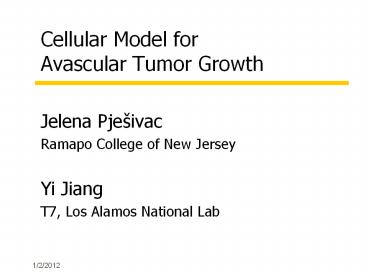Cellular Model for Avascular Tumor Growth - PowerPoint PPT Presentation
1 / 22
Title:
Cellular Model for Avascular Tumor Growth
Description:
V-79 Chinese hamster lung cancer. cross section. Mean diameter and standard deviation of ... and waste, respectively, of cell occupying site (x,y,z) c = F(a, b) ... – PowerPoint PPT presentation
Number of Views:211
Avg rating:3.0/5.0
Title: Cellular Model for Avascular Tumor Growth
1
Cellular Model for Avascular Tumor Growth
- Jelena Pješivac
- Ramapo College of New Jersey
- Yi Jiang
- T7, Los Alamos National Lab
2
Outline
- Tumor
- Existing/Relevant Models
- Model for Avascular Tumor Growth
- Results
- Summary
- Future development
3
Tumor
- Tumor (neoplasm) is a relentlessly growing mass
of abnormal cells, whose growth rate exceeds the
growth rate of surrounding normal cells. - Avascular tumor is a benign tumor that grows in a
spherical, layered structure consisting of
necrotic, quiescent and proliferating cells.
4
Tumor, cont.
Malignant brain tumor (glioma)
- Outer layer - viable rim
- Intermediate layer - quiescent cells
- The innermost layer - necrotic core
Interdisciplinary Development of Computational
Tumor Model Torquato S., Deisboeck T.S.
http//www.elsevier.com/locate/biosystems/
5
Existing/Relevant models
- Continuum Models
- Rate Equations of Population Growth
- Coupled Reaction-Diffusion Equations
- Discrete Models
- Cellular Automata
- Q Potts model
- Original
- Extensions
6
Original Q Potts model
- Cells are positioned on a lattice
- Each cell is assigned unique ID
- Driving force is minimization of surface energy
- Evolution
- a random site is chosen and assigned to one of
its neighbors - ?H is calculated
- probability of accepting this change is
7
Extended Q Potts model
- Includes various extensions to Original Q Potts
model - Coupling between spins (e.g. surface tension)
- Coupling to external fields (e.g. potential
energy) - Constrains (e.g. surface or area constrain)
- Applications
- Grain growth in polycrystalline solids
- Foam drainage and rheology
- Cell sorting and growth
- etc.
8
Model for Avascular Tumor Growth
- Processes to be considered in simulating
- tumor growth
- cell-environment chemotaxis interactions
- intercellular adhesion
- mitosis and cell growth
- mutations
- nutrient absorption and diffusion
- waste production and diffusion
- geometry and structure of cells
9
Multicellular Tumor Spheroid
- MTS is an in vitro tumor model
- Used to assay tumor growth, reaction to the
treatments, cell signaling, etc. - Distinct phases in the growth of MTS
- initial phase (exponential growth)
- layering phase
- plateau phase
10
Multicellular Tumor Spheroid, cont.
Mean diameter and standard deviation of 70
isolated MTS
V-79 Chinese hamster lung cancer cross section
Folkman and Hochberg 1973
11
Our Model
- Extended large-Q Potts model in 3D
- Lattice Monte Carlo model coupled with continuous
reaction-diffusion chemical dynamics - Includes all important processes in a tumor cell
growth
12
Total energy
- Total energy of the cell aggregate
S - cell identification number ?(S) - cell type
(proliferating, quiescent, or necrotic) J?(S)?(S)
- coupling energy between cell types ?(S) and
?(S) ? v - elasticity vs - cell Volume Vs -
target Volume
13
ChemicalReaction-diffusion dynamics
DO2, Dn, Dw diffusion constants for oxygen,
nutrients, and waste, respectively a, b, c
consumption/production rate of oxygen, nutrients
and waste, respectively, of cell occupying site
(x,y,z) c F(a, b)
14
Results Early Spheroid growth Number of Cells
vs. Time
15
Results Chemical distribution
16
Results Beginning of Layering phase
Tumor aggregate after 440 Monte Carlo steps Cell
quiescence occurred
17
Results Number of cells vs. time
18
Summary
- At early stage of MTS development, exponential
growth of the aggregate was obtained. This is
consistent with experiments. - Nutrient deficit/waste production could cause
quiescence - Plateau phase, that starts with onset of necrosis
will occur in near future
19
For future development
- Detailed comparison to the existing spheroid
experimental data - Extending model to describe vascular tumors by
introducing angiogenesis - Chemotaxis
- Development of continuous cellular model?
- combining continuous and discrete model in a
unique integrated cellular model
20
Angiogenesis
- Process in which new blood vessels are formed
- Occurs in
- healthy body
- healing wounds
- restoring blood flow to tissues
- after injury
- tumors/cancers
- Controlled by
- Stimulating growth factors
- Inhibitors
21
Chemotaxis
- Movement of cell along a chemical concentration
gradient either toward or away from the chemical
stimulus - Total energy term would have to be modified to
include
? - effective chemical potential towards the
chemical C(x,y,z,t) - local concentration of the
chemical at the time t
- Dictyostelium Mound Formation
22
Reference
- Suthreland R.M., Cell and Environment
Interactions in Tumor Microregions The Multicell
Spheroid Model - Freyer J.P., Sutherland R.M., Proliferative and
Clonogenic Heterogeneity of cells from EMT/Ro
Multicellular Tumor Spheroids induced by the
glucose and oxygen supply - Freyer J.P., Role of Necrosis in Regulating the
Growth Saturation of Multicellular Tumor
Spheroids - E.L. Stott, N.F. Britton, J.A. Glazier, M. Zajac,
Stochastic Simulation of Benign Avascular Tumor
Growth Using the Potts Model - Y. Jiang, H. Levine, J.A. Glazier, Possible
collaboration of Differential Adhesion and
Chemotaxis Cooperate in Mound Formation of
Dictyostelium































